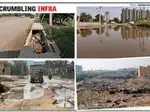At 12.8%, transport primary vehicle of bad air in capital

The average AQI of 292 was the worst in Oct. On Thursday, it was 285. The air quality at 15 out of the 36 monitoring stations was ‘very poor’ while no area, including Anand Vihar, was in the ‘severe’ category. An AQI between 201-300 is considered ‘poor’ and the one between 301-400 is ‘very poor’.
The main source of pollution was PM10 or the coarser particles. According to Central Pollution Control Board, the PM2.5 levels oscillated between 115.8 and 118.2 micrograms per cubic metre. The national standard for PM2.5 is 60 units and World Health Organization puts it at 15 for 24 hours. PM10 oscillated between 265.2 and 270 micrograms per cubic metre.
Pollutants also entered the national capital from neighbouring cities, with Gautam Budh Nagar in Uttar Pradesh contributing 11.4%, followed by 7.8% from Bulandshahr, 6.6% from Ghaziabad and 4.8% from Faridabad. Meanwhile, the farm fires continued, with 59 incidents being recorded in Punjab, 26 in Haryana, 47 in UP and three in Delhi. Since Sept 15, there were 1,348 stubble burning incidents in Punjab, 627 in Haryana, 657 in UP and 11 in Delhi.
According to the air quality early warning system, AQI is likely to turn ‘very poor’ in Delhi by Sunday as weather conditions are not favourable to ventilate the additional pollutants coming from stubble or waste burning. “The air quality is likely to be in the ‘poor’ category on Saturday. The air quality is likely to reach the ‘very poor’ category on Sunday and remain there on Monday,” it stated, adding that AQI is likely to oscillate between ‘very poor’ and ‘poor’ for the next six days.
“Met conditions are highly unfavourable for the effective dispersion of pollutants. Additional emissions from sources such as stubble/waste burning are likely to deteriorate air quality significantly,” the air quality early warning system predicted.

